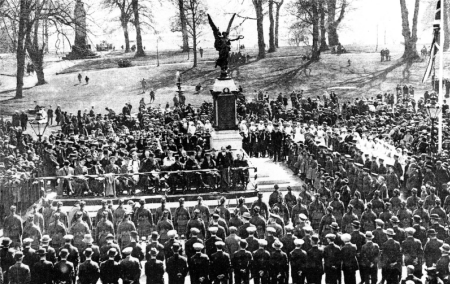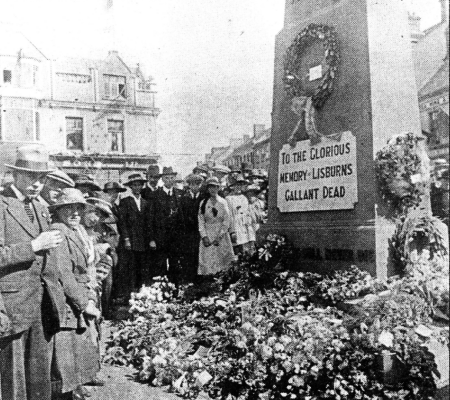
The unveiling of the War Memorial in Castle
Gardens in 1923.
This Sunday July 1 Lisburn's War Memorial in Castle
Gardens, which was recently cleaned and new names added, will be
rededicated In anticipation of the event, Rev Canon Alex
Cheevers, Chaplain of the Royal British Legion in Lisburn,
shares some of the stories behind the names on the stone
memorial and tells of the day, in 1923, when it was unveiled for
the first time
TODAY they are names carved in stone on our
City War Memorial in Castle Gardens in Lisburn. Names from as
long ago as 1914, right up to more recent times.
Many of the young people going in and out of
the College across the way, or standing around the Memorial, may
not give those names a second glance or thought yet behind every
name on the Memorial is a story that reflects an enormous amount
of personal grieving.
One such story is that of James Dunleavy, the
great-grandfather of former Mayor of Lisburn, Alderman Seamus
Close. James Dunleavy was born at Blaris in 1864. He married
Agnes Close, and they lived in the Antrim Street area of
Lisburn. They had three children, Sarah, Kate and Jane. James
served in the Boer War of 1899 to 1902, and again in the First
World War.
On Lisburn War Memorial he is listed as
Rifleman, but the Roll of Honour shows him as Sergeant. He was
in the 11th Battalion of the Royal Ulster Rifles (South Antrim
Volunteers), and arrived in France around October 4, 1915. He
went into action on the opening morning of the Battle of the
Somme, July 1 1916. He was killed as he advanced with his
Battalion, being one of those who have no known grave.
He is commemorated on the Thiepval Memorial
to the Missing, near to where he was killed. He had served a
total of 18 years in the Army, and was 52 years of age � older
than the average casualty
 |
|
The wooden cenotaph erected in Market
Square Peace Day celebrations in 1919. |
When James Dunleavy and the other fallen from
the Lisburn area were first commemorated it was at a temporary
wooden War Memorial placed in Market Square. It had been put in
place and dedicated on August 16, 1919, just nine months after
the end of the First World War.
The grief in Lisburn families was so enormous
there was a need to give people a focus for their tears.
That Memorial was in place until the present,
permanent Memorial was erected, and then unveiled and dedicated
on Saturday April 28, 1923. It was a momentous day for the
grieving families of Lisburn.
The Lisburn Standard reported that around 200
wreaths were laid that day by all kinds of dignitaries, and by
grieving families remembering their loved ones. But I personally
am pleased that they also mentioned that "a poorly clad little
girl came forward and laid a little posy of natural flowers she
had gathered in the fields."
The day of the unveiling and dedication of
the Memorial with its 266 names was very much a civic day. All
business in the town was suspended from just before the
ceremony. The Chairman of Lisburn Urban Council, Mr. Ezekiel.
Bullick, opened the proceedings, and a hymn was sung, led by the
Temperance Silver Band.
The Service was conducted by the local
clergy. Major General Sir Oliver Nugent, who had commanded the
36th Ulster Division for two and a half years in Flanders, was
the honoured guest and he officially unveiled the Memorial. The
memorial bore the names of those from the Lisburn area who had
gone off voluntarily, without conscription, to serve their
country. And they had paid the ultimate price.
The War Memorial was officially handed over
that day into the care of Lisburn Urban Council. Since then they
have been responsible for its maintenance and for having names
added. On July 1, the newest names to be added to the memorial
will be unveiled.